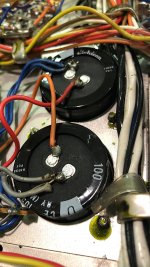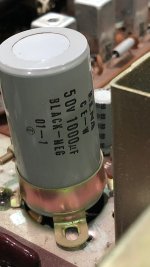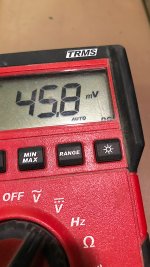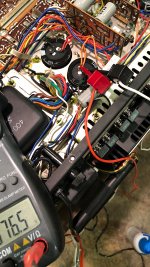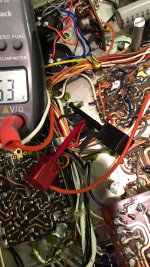Sure, electrically it is fine. Remember that we had to use 35mm diameter capacitors because of the clamps,
and this size is not available in all capacitance values.
and this size is not available in all capacitance values.
Last edited:
Yes, under 100mV is acceptable, though not ideal.
If you have no scope, use junk speakers for burn-in, if possible.
Power down the amplifier before connecting speakers.
If you have no scope, use junk speakers for burn-in, if possible.
Power down the amplifier before connecting speakers.
Last edited:
Power down and disconnect the speakers. Then turn it back on.
What is the DC voltage on each capacitor?
What is the DC voltage on each capacitor?
On two of the large caps there should be 76VDC.
On the other two large caps there should be 38VDC.
On the smaller cap there should be 35VDC.
It appears that the main power supply is ok.
Can you power down, unplug the AC cord, wait until all capacitors are completely discharged
(check with the meter), and check the two 4A power supply fuses? Are they both blown?
On the other two large caps there should be 38VDC.
On the smaller cap there should be 35VDC.
It appears that the main power supply is ok.
Can you power down, unplug the AC cord, wait until all capacitors are completely discharged
(check with the meter), and check the two 4A power supply fuses? Are they both blown?
Last edited:
Voltages you describe is about right. 76 on first two big and 36 on second pair. There 3 fuses 2 for speakers and only one for power. All 3 measured fine.
If the amplifier output is weak and distorted that suggests it could have a gain of unity i.e the lower nfb RC divider arm does not connect to earth in both channels suggesting a common route is not making a proper contact. The capacitors within that route could also have become leaky.
Voltages you describe is about right. 76 on first two big and 36 on second pair.
There 3 fuses 2 for speakers and only one for power. All 3 measured fine.
The power supply is now ok, but it appears more electrolytic capacitors may be bad.
Start making a list from the parts lists in the service manual, there are a fair number
of them, located on several pcbs. Verify that all the caps on your list are electrolytics,
since there is normally no reason to replace film type capacitors.
Sansui 5000A AM/FM Stereo Tuner Amplifier Manual | HiFi Engine
At this point, all the remaining electrolytics should be replaced, to avoid wasting time
looking for individual bad ones.
Last edited:
- Home
- Amplifiers
- Solid State
- amplifier output weak and distorted.
